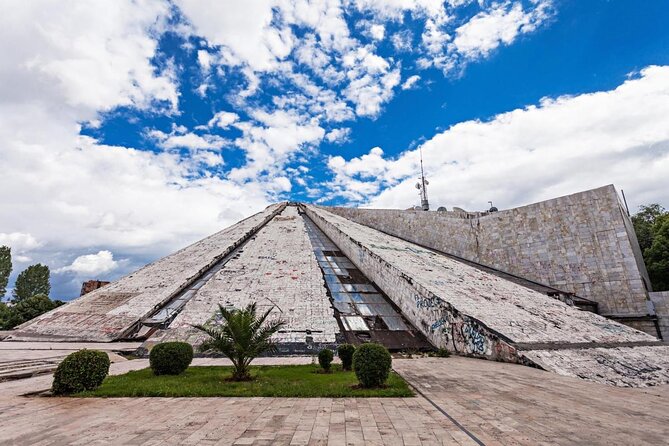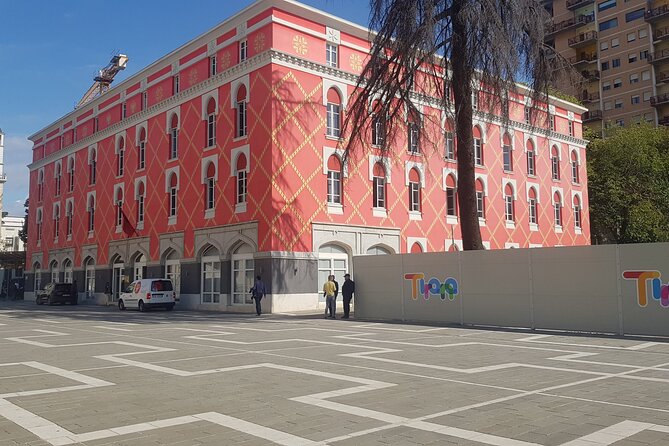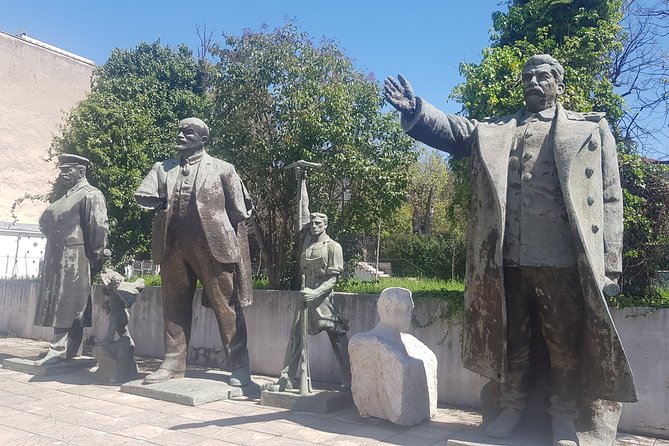In exploring ‘A Communist Manifesto: Tirana Before and After,’ one can’t help but notice the stark contrast between the city’s oppressive past and its vibrant present. Once cloaked in the gray tones of communist ideology, Tirana now bursts with color, inviting locals and visitors alike to embrace its cultural renaissance. Key landmarks like the Pyramid of Tirana and Bunkart 2 stir memories of a bygone era, prompting questions about identity and resilience. What lessons does this transformation hold for other cities grappling with their histories? The answers may surprise those willing to consider the journey.
Key Points

- Tirana’s identity was profoundly shaped by Communism, with state propaganda and public works redefining the urban landscape from the 1940s to the early ’90s.
- Key landmarks like the Pyramid of Tirana and Bunkart 2 highlight the city’s complex history and serve as reminders of the Communist regime.
- Skanderbeg Square has transformed from a symbol of oppression into a vibrant cultural hub, featuring colorful fountains and green spaces for community activities.
- Modern Tirana showcases a cultural shift, blending historical elements with contemporary influences, including street art and diverse culinary offerings.
- Local perspectives reveal a mix of pride and concern over rapid changes, as historic landmarks coexist with modern structures, reflecting an evolving identity.
Historical Significance of Communism
Communism played a pivotal role in shaping Tirana’s identity, leaving behind a legacy that visitors can still explore today.
From the 1940s until the early ’90s, the regime transformed the city’s landscape and social fabric. State propaganda adorned the walls, while massive public works projects aimed to showcase the regime’s might. The government prioritized education and healthcare, fostering a sense of community, but it also stifled dissent and freedom.
Today, remnants of this era, like the Pyramid of Tirana and various bunkers, serve as reminders of a complex history. As travelers stroll through the city, they can appreciate how these historical layers contribute to Tirana’s unique character, allowing them to engage with a past that’s both fascinating and tumultuous.
You can also read our reviews of more tours and experiences in Tirana.
Key Landmarks of Communist Era

During the Communist era, several key landmarks emerged in Tirana, each telling a story of the regime’s ambitions and its impact on the city’s landscape.
The Pyramid of Tirana, initially built as a museum for Enver Hoxha, stands as a stark reminder of the past, while Bunkart 2 offers a glimpse into the extensive network of bunkers designed for protection.
The National Arts Gallery, another significant site, showcases how art was used as a propaganda tool.
The imposing Mother Albania statue on the outskirts symbolizes the country’s struggle and resilience.
Each of these landmarks serves not just as historical sites but as conversation starters about the complexities of Tirana’s Communist legacy and its ongoing transformation.
Transformation of Skanderbeg Square

Skanderbeg Square has undergone a remarkable transformation that reflects Tirana’s shift from a stark Communist past to a vibrant, modern city center. Once a symbol of oppression, the square now buzzes with energy and life.
Visitors are drawn to its lively atmosphere, where they can experience:
- Colorful fountains that dance in the sunlight, inviting families to gather.
- Expansive green spaces perfect for leisurely strolls or enjoying a book.
- Bustling cafes and shops that offer locals and travelers a taste of contemporary culture.
This revitalization not only honors the city’s history but also embraces a brighter future. Skanderbeg Square now stands as a testament to Tirana’s resilience and creativity, celebrating its diverse community in a welcoming environment.
The Pyramid of Tirana
Rising majestically in the heart of Tirana, the Pyramid of Tirana serves as a striking reminder of the city’s complex past and its ongoing journey toward modernity. Originally built in 1988 as a museum to honor Enver Hoxha, the former communist leader, it now stands as a multifunctional space, hosting art exhibitions and cultural events.
Its unique architectural design, featuring sharp angles and a spacious interior, sparks curiosity among locals and visitors alike. Over time, the pyramid has become a canvas for street artists, reflecting the city’s vibrant artistic spirit.
As Tirana continues to evolve, the pyramid symbolizes resilience, bridging the gap between its tumultuous history and a hopeful future. It’s a must-see landmark for those exploring the city.
Bunkart 2: A Historical Museum
Exploring Bunkart 2 offers a unique glimpse into Albania’s Communist past, as this former bunker has been transformed into a captivating museum. Visitors step into a world where history unfolds through immersive exhibits and artifacts. The experience is both educational and thought-provoking, shedding light on the era’s impact on everyday life.
Here are three highlights that make Bunkart 2 a must-visit:
- Authentic Historical Artifacts: Explore items like propaganda posters and personal belongings from the Communist regime.
- Interactive Displays: Engage with multimedia presentations that bring the stark realities of the time to life.
- Underground Bunker Architecture: Marvel at the intricate design of a bunker built for protection, now housing poignant reminders of the past.
This museum invites reflection on a complex history.
Modern Tirana: A Cultural Shift

Modern Tirana showcases a vibrant cultural shift, blending its rich historical roots with contemporary influences that breathe new life into the city.
Street art flourishes on once-barren walls, reflecting the youthful energy and creativity of its residents.
Cafés buzz with conversations, where locals and visitors alike savor traditional Albanian cuisine alongside international dishes.
Cultural events, from music festivals to art exhibitions, now fill the calendar, fostering a sense of community and collaboration.
The architectural landscape transforms, with modern buildings standing in contrast to historical landmarks, creating a unique skyline.
This evolution not only honors Tirana’s past but also embraces the future, drawing people in and making the city a dynamic hub for culture, art, and social interaction.
Local Perspectives on Change

As Tirana undergoes rapid transformation, locals share a mix of pride and concern about how these changes reflect their identity and the city’s future. Many people feel excited about the modernization, yet some worry about losing the essence of their culture.
They describe the shift with vivid images:
- Colorful murals sprouting on once-gray buildings, breathing life into the cityscape.
- Cafés bustling with chatter and laughter, showcasing a vibrant social scene that attracts both locals and travelers.
- Historic landmarks standing alongside sleek new structures, a constant reminder of the past amid progress.
This duality of emotions speaks volumes about the ongoing journey of Tirana, where hope and nostalgia intertwine in the hearts of its people.
Walking Tours: A Unique Experience

Walking through Tirana with a knowledgeable guide reveals the city’s rich history and vibrant culture in a way that’s both engaging and personal.
Travelers embark on a journey through key locations like Skanderbeg Square and the Pyramid of Tirana, uncovering stories from Albania’s Communist past.
With a maximum of 15 participants per tour, the intimate setting fosters interaction and deeper understanding.
The experience includes coffee or tea, and lunch, ensuring comfort throughout the walk.
Accessibility is a priority, with options for wheelchairs and strollers.
Rated 5.0 from 46 reviews, participants consistently praise the insightful history and personal anecdotes shared by guides.
For anyone curious about Tirana’s transformation, these walking tours offer a unique, memorable experience.
Frequently Asked Questions
What Should I Wear for the Walking Tour in Tirana?
For the walking tour in Tirana, she should wear comfortable shoes, lightweight clothing, and a sun hat. A light jacket might help in cooler weather, ensuring she enjoys exploring without discomfort. Don’t forget sunscreen!
Are There Any Age Restrictions for Participants in the Tour?
There aren’t any age restrictions for participants in the tour. Families with children, seniors, and everyone in between can enjoy exploring Tirana’s rich history together. It’s designed to be inclusive and accessible for all.
Is the Walking Tour Available in Multiple Languages?
The walking tour’s available in multiple languages, ensuring everyone can connect with Tirana’s rich history. Travelers appreciate the guides’ ability to share stories in their preferred language, making the experience even more engaging and memorable.
Can I Bring My Pet on the Walking Tour?
She asked if pets could join the walking tour. The guide confirmed that while service animals are welcome, pets aren’t permitted. Travelers can enjoy the experience without worrying about their furry companions on this historical journey.
What Safety Measures Are in Place During the Tour?
The tour prioritizes safety by ensuring guides are trained in emergency protocols, maintaining small group sizes for better supervision, and providing clear instructions on local regulations. Participants feel secure while exploring Tirana’s rich history together.
Recap
To sum it up, Tirana’s journey from a communist stronghold to a vibrant cultural hub is nothing short of remarkable.
The city’s transformation, marked by colorful murals and lively spaces, invites both locals and visitors to reflect on its complex history.
Landmarks like the Pyramid and Bunkart 2 serve as reminders of the past while celebrating resilience and identity.
As you stroll through Skanderbeg Square or join a walking tour, you can truly feel the pulse of modern Tirana.
More Tour Reviews in Tirana
- Tirana: A walk through the history of Albania.
- From Tirana/Durrës/Golem: Theth, Blue Eye & Waterfall Tour
- Traditional Albanian Cooking Class in Tirana & Raki Tasting
- From Tirana: Bovilla Lake and Panorama Hike Day Trip
- Tirana: Virtual Tour of Art Bunkers Bunk’Art 1 and 2
- Discover Tirana: Panoramic Tour and Walk around the Artificial Lake
Not for you? Here's more nearby things to do in Tirana we have reviewed
- Tirana: A walk through the history of Albania.
- From Tirana/Durrës/Golem: Theth, Blue Eye & Waterfall Tour
- Traditional Albanian Cooking Class in Tirana & Raki Tasting
- From Tirana: Bovilla Lake and Panorama Hike Day Trip
- Tirana: Virtual Tour of Art Bunkers Bunk’Art 1 and 2
- Discover Tirana: Panoramic Tour and Walk around the Artificial Lake
- Durres, Tirana & Golem: Karaburun & Sazan Boat Tour
- From Tirana: Spaç Prison Tour with Entrance Fees
- From Tirana/Durres Albanian Alps and Theth: Full Day Tour
- Tirana Walking Tour & Dajti Mountain with Cable Car Included
- From Tirane To Bovilla Lake & Gamti Mountain SUNNSET TIME
- Tirana: Dajti Mountain Half-Day Trip with Cable Car Ticket
